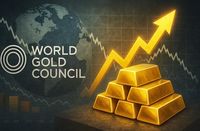On April 11, 2025, gold prices experienced significant fluctuations, starting with a sharp increase in the morning followed by a sudden decline by the afternoon. This volatility in the gold market has caught the attention of investors and analysts alike, as it reflects broader economic concerns.
In the morning, the price of gold rings and SJC gold surged by an average of 2.8 million VND per tael. Major brands such as PNJ, SJC, and DOJI adjusted their gold miếng prices to range between 103.4 - 106.4 million VND per tael. Similarly, gold ring prices also saw a notable rise, with PNJ trading at 101.9 - 105.1 million VND per tael. SJC and DOJI followed suit, adjusting their prices to 102.4 - 105.6 million VND and 101.2 - 104.1 million VND per tael, respectively.
However, by the afternoon, the domestic gold prices reversed course dramatically. Gold miếng prices at major brands like PNJ, SJC, DOJI, and Bảo Tín Minh Châu dropped sharply by 700,000 VND per tael in both buying and selling directions compared to the historical peak established earlier in the day. As of the afternoon, gold miếng was trading around 102.7 - 105.7 million VND per tael, while gold ring prices also faced a significant downward adjustment. Bảo Tín Minh Châu reduced its gold ring prices by 1.7 - 1.9 million VND per tael, bringing them down to 100.9 - 104.5 million VND per tael.
PNJ listed its gold rings at 100.8 - 104.3 million VND per tael, reflecting a decrease of 1.1 million VND on the buying side and 700,000 VND on the selling side. SJC lowered its gold ring prices to 101.4 - 104.4 million VND per tael, marking a decrease of 1 million VND per tael. DOJI also adjusted its prices downward by 700,000 VND per tael, currently buying and selling at 100.5 - 103.4 million VND per tael.
Overall, compared to the peak prices set earlier in the day, gold miếng prices have decreased by approximately 1.2 million VND per tael, while gold ring prices have seen a more significant drop of nearly 2 million VND per tael.
On the international market, spot gold was priced at 3,205 USD per ounce, which is an increase of 30 USD compared to the previous trading session. According to a recent report from the World Gold Council (WGC), there are increasing concerns that the U.S. economy may experience slower growth and higher inflation, prompting investors to shift their focus towards gold.
The report highlights that there has been a stable inflow of funds into gold-backed exchange-traded funds (ETFs) since the beginning of the year. In March 2025 alone, a total of 92 tons of gold, valued at 8.6 billion USD, flowed into global ETFs. In the first quarter of 2025, capital flows into these ETFs reached 226 tons of gold, worth 21 billion USD, marking the second-highest level in terms of USD value in a quarter, only surpassed by the second quarter of 2020.
Regionally, North American ETFs accounted for 61% of total inflows, while European markets contributed approximately 22%, and Asian markets contributed 16%. Analysts noted that the European funds, previously lagging behind, are beginning to catch up, with first-quarter capital flows in Europe reaching 4.6 billion USD, the strongest quarter since the first quarter of 2020.
Demand in Europe has seen an uptick, with countries like the UK, Switzerland, and Germany recording increases in gold holdings. The report indicates that while the Bank of England did not change the standard interest rate during its March meeting, the uncertain growth outlook due to concerns about U.S. tariffs, weak stock market performance, and soaring gold prices have boosted gold investment demand in the UK.
In Asia, demand was primarily led by China and Japan, driven by the strong performance of gold prices, which outperformed other asset classes during the month, alongside escalating risks from global trade policies. The WGC report emphasizes that the current market is supported by strong momentum, despite the potential risks that the upward trend in gold prices may not be sustainable.
Furthermore, analysts have pointed out that the current scale and speed of gold price increases are reminiscent of previous peaks, yet the macroeconomic conditions today are notably different from those periods. The trend of holding gold and the reluctance to sell, attributed to current policy instability, may create a robust momentum in the market.
As the gold market continues to navigate through these fluctuations, investors and analysts are keeping a close eye on various economic indicators that could influence future price movements. The interplay of global economic conditions, inflation fears, and geopolitical tensions will likely dictate the trajectory of gold prices in the coming weeks and months.





